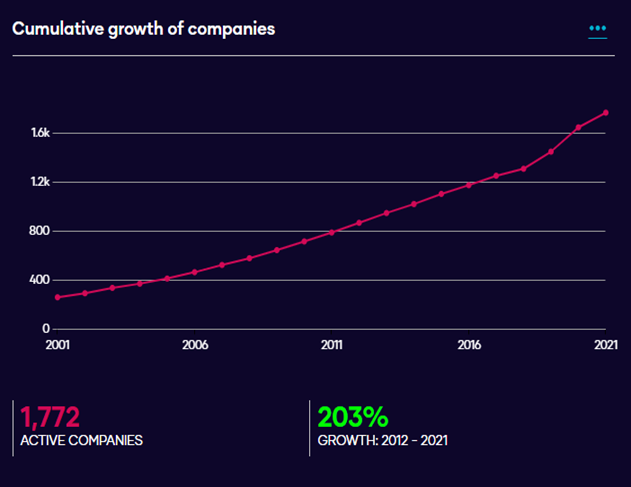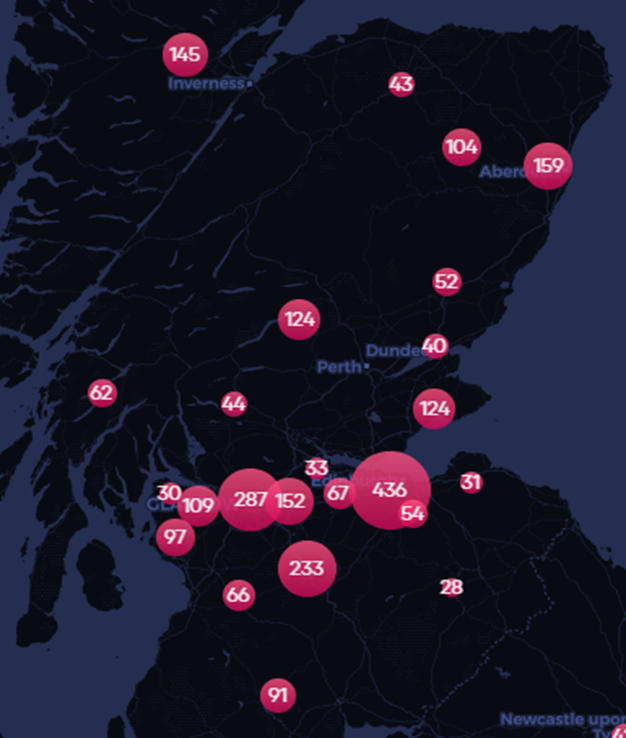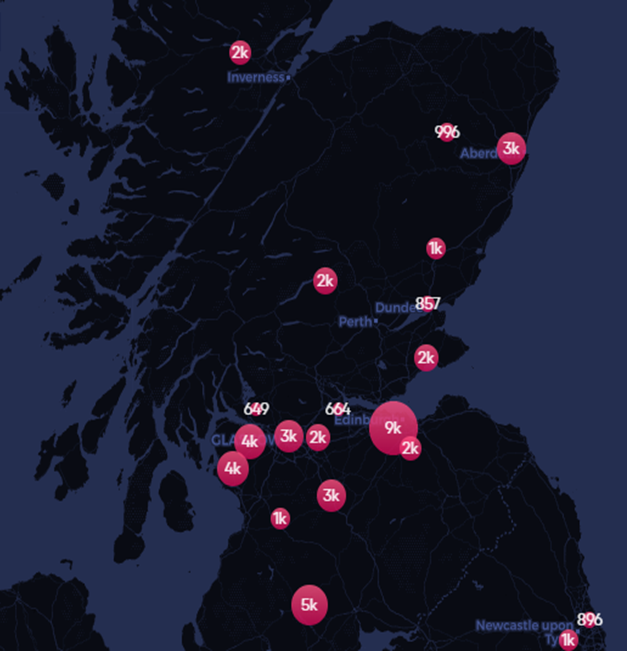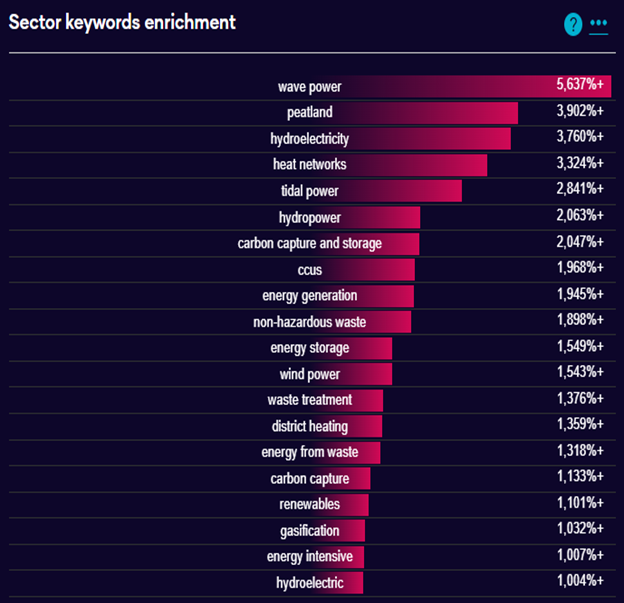
Insight
Optimat and The Data City have created a detailed dataset of Scotland’s net zero supply chain. Together we have found 1,800 companies that are actively involved in reducing greenhouse gas emissions, demonstrating the scale of the sector in Scotland and its potential for further growth.
During the last ten years we,ve been involved in programme design and delivery aimed at a wide variety of economic development projects, including improving the technology expertise landscape in areas such as low-carbon technology.
Our work is often cross-sectoral in nature, and nowhere is that more evident as an approach than in the transition to net zero. The recent data that we,ve collected, some of which is summarised below, demonstrates that there are significant regional opportunities in specific technology, sector and capabilities that, when combined, can help Scotland to achieve net zero emissions of all greenhouse gases by 2045.
This new dataset provides valuable insight into the supply chain, its geography and its interdependencies. It demonstrates the scale and potential for the sector as well as highlighting early stage growth companies and the potential to create green jobs. It also highlights the relationships between different supply chains that can be used to support a Just Transition.
Scotland has already started its journey to net zero
Scotland already has an enviable track record. Its greenhouse gas emissions have reduced 31% since 2008, faster than any G20 economy. This is reflected in the number of companies in the Scottish net zero supply chain, which grew by 200% between 2012 and 2021. Their combined turnover in 2020 was £22.5bn.

Image one: The growth of the net zero supply chain in Scotland 2012-21
The supply chain is made up of businesses of all sizes and types. However, looking at profit after tax, the top 5 companies operating in the supply chain are largely in energy generation.
- Scottishpower Renewables (Glasgow) https://www.scottishpowerrenewables.com/
- SSE (Perth and UK) https://www.sse.com/
- Beatrice Offshore Windfarm (Wick) https://www.beatricewind.com/
- Global Marine Group (Aberdeen and other UK) https://globalmarine.group/
- Simec Atlantic Energy (Edinburgh, other UK and Singapore) https://simecatlantis.com/
Defining Scotland’s Net Zero supply chain
Our work is based on analysis of company websites, using AI to understand what they do and combining this with records at Companies House and insight from other sources. This produces real-time industrial classifications (RTICs). The system, developed by The Data City, overcomes many of the flaws in standardised industrial classification (SIC) which tends to under-represent new industries having been last updated in 2007. It also means that we can understand the segments within a supply chain in detail.
The net zero supply chain includes a number of subgroups, which include Agritech, Building Technologies, Carbon Capture, Diversion of Biodegradable Waste from Landfill, Energy Cooperatives, Energy Storage, Green Finance, Grid, Heating, Low Carbon, Low Carbon Consultancy Advisory and Offsetting Services, Low Emission Vehicles, Pollution Control and Mitigation, Renewables, Renewable Energy Planning Database, Waste Management and Recycling.
The nature of RTICs means that one company might be classified in more than one industry vertical. This allows us to understand the relationships and interactions between different industry verticals of the net zero supply chain in detail. A list of companies in each subgroup is available from The Data City.
- Renewables and renewable energy 1507 companies
- Waste Management and Recycling 279 companies
- Low Carbon Energy Generation 250 companies
- Low Carbon Consultancy, Advisory and Offsetting Services 189 companies
- Energy Generation: Wind 166 companies
- Diversion of Biodegradable Waste from Landfill 159 companies
- Net Zero: Heating 100 companies
- Low Emission Vehicles 87 companies
- Energy Storage 86 companies
- Energy Generation: Hydropower 67 companies
- Grid 60 companies
- Energy Cooperatives 51 companies
- Energy Generation: Renewable Thermal 48 companies
- Energy Generation: Solar 48 companies
- Building Technologies 41 companies
- CleanTech: Energy Production, Management and Storage 41 companies
- Li-ion battery supply chain: Battery assembly 37 companies
- Data Infrastructure: Data Storage 37 companies
- Net Zero: Pollution Control and Mitigation 28 companies
- Energy Storage: Batteries 28 companies
- Energy Generation: Bioenergy 27 companies
- Net Zero: Agritech 22 companies
- Energy Management: Energy Management Systems 20 companies
- Li-ion battery supply chain: Battery cells 18 companies
- Data Infrastructure: Data Centres 18 companies
- Energy Management: AI and IoT 16 companies
- Energy Generation: Hydrogen 15 companies
- Net Zero: Carbon Capture 13 companies
- Geospatial Economy: Data Capture 13 companies
- FoodTech: Food Surplus 12 companies
- Energy Management: Smart Meter 12 companies
- Net Zero: Green Finance 11 companies
- FoodTech: AgriTech 10 companies
- Energy Storage: Mechanical 10 companies
- Artificial Intelligence: GreenTech 9 companies
- Photonics: Photovoltaics 9 companies
- Internet of Things (IoT): Smart Buildings 8 companies
- Design and Modelling Technologies: Digital Twins 8 companies
Identifying regional opportunities in Net Zero
We can take this list of segments and use it to analyse the net zero supply chain in each local authority in Scotland.
A basic analysis reveals that the companies are distributed across Scotland. Outside of Edinburgh and Glasgow, there are significant clusters in South Lanarkshire, Aberdeen, North Lanarkshire, Highland, Renfrewshire, Perth and Kinross, Aberdeenshire, North Ayrshire and Dumfries and Galloway.

Image two: Companies in the net zero supply chain by local authority
Data at this level has a valuable role to play in aiding industrial development, infrastructure programmes, business growth and technology exploitation policies. It is possible to see specific patterns emerging. For example, Aberdeen and Aberdeenshire provide a home to a cluster of companies specialising in energy generation, low carbon consultancy, advisory and offsetting services and renewables. This has fueled a 300% growth in net zero companies in Aberdeen between 2012 and 2021. There is also a renewables, waste management and recycling cluster in South Lanarkshire, with the largest operator being Enva in Blantyre. Unsurprisingly, Highland contains a number of wind and offshore wind companies, with the most significant being Statkraft.
Employment and a Just Transition
It’s no surprise to see Edinburgh and Glasgow as the major centres of employment as many companies, main offices are located in the two cities. However, our data also highlights significant clusters of employment in the net zero supply chain in Dumfries and Galloway, South Lanarkshire, North Ayrshire, Renfrewshire, and Aberdeen.

Image three: Clusters of employment in the net zero supply chain
Keywords demonstrate the centrality of Scotland’s natural assets to the sector
The data also allows us to see the keywords used by companies in this sector and to understand which keywords are over-represented and under-represented among companies in the Scottish net zero supply chain compared to the average UK company. For example, a value of ‚Äòwave power +5637%, means that the companies in our list and matching our filters are much more likely to mention the phrase ‚Äòwave power, on their website than the average UK company. Our analysis clearly shows the value of Scotland’s natural assets of wave, peat and water are of central importance to the sector.

Image four: Words that companies in Scotland’s net zero supply chain are more
likely to feature on their websites than the average UK company.
Working together to transition to net zero
Optimat is already engaged in a number of projects to reduce greenhouse gas emissions and aid the transition to a net zero economy in Scotland. There are a number of applications for it including:
- Designing appropriate business support or infrastructure programmes
- Supporting a Just Transition to net zero by enhancing business capacity for innovation activity through well-designed, cross-sectoral programmes
- Identifying regional opportunities in the net zero supply chain
- Improving the technology expertise landscape
- Reviewing strategy and policy initiatives both locally and nationally
- Supporting specific sectors such as renewable energy generation
- Attracting investment into local clusters, particularly for innovative technologies
Contact us if you would like to talk about the data that we,ve summarised in this post.
 
